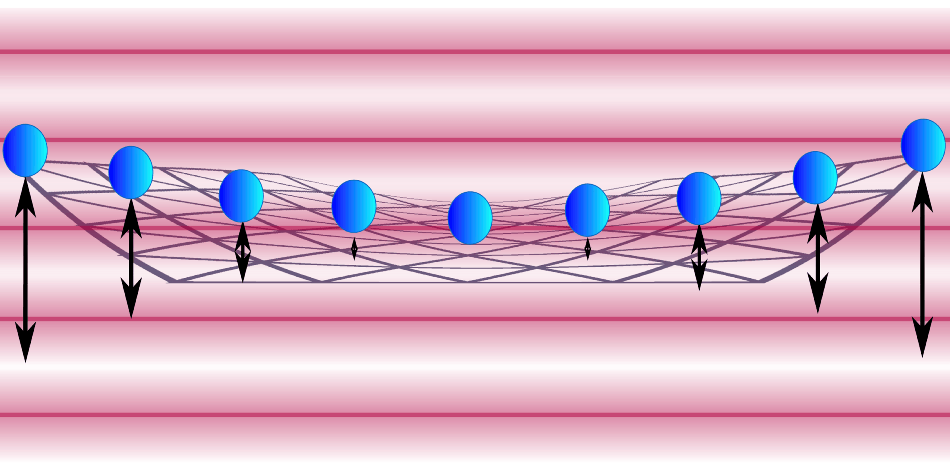Feb 21 2019
A flat crystal of 150 beryllium ions (electrically charged atoms) has been “flash-frozen” by physicists from the National Institute of Standards and Technology (NIST), paving the way for new opportunities to simulate magnetism at the quantum scale and to sense signals emitted by mysterious dark matter.
 Illustration of vibrating beryllium ions (electrically charged atoms) trapped in a crystal formation. NIST researchers cooled and slowed these “drumhead” vibrations to nearly motionless. (Image credit: Jordan/NIST)
Illustration of vibrating beryllium ions (electrically charged atoms) trapped in a crystal formation. NIST researchers cooled and slowed these “drumhead” vibrations to nearly motionless. (Image credit: Jordan/NIST)
For several decades, a number of scientists have made attempts to chill vibrating objects that are sufficiently large to be visible to the naked human eye to an extent that they have the minimum motion permitted by quantum mechanics—the theory that regulates the behavior of matter at the atomic scale. The colder the better since it renders the device more stable, more sensitive, and less distorted, and hence more useful for practical applications. However, to date, scientists could only minimize a few vibration types.
In the experiment performed at NIST, electric and magnetic fields were used to cool and trap the ions such that they formed a disk with a diameter of less than 250 μm, or one-millionth of 1 m. The disk is regarded to be a crystal since the ions in it are arranged in a regularly repeating pattern.
As reported in Physical Review Letters, the NIST scientists cooled the crystal within a time span of 200 μs, or one-millionth of 1 second, such that the energy of each ion was about one-third of the energy carried by a single phonon—a packet of motional energy in the crystal. This stands very close to the amount of energy in the lowest possible quantum “ground” state for the so-called “drumhead” vibrations of the crystal, which are analogous to a beating drum’s up-and-down motions.
The scientists chilled and slowed down all 150 drumhead vibrations—one for each ion. (The simulation video below illustrates eight example types of drumhead vibrations.) The study demonstrated that it is possible to collectively slow down hundreds of ions using this method, which is a significant progress over the earlier demonstration by another team that cooled a line of 18 ions.
NIST researchers chilled and slowed “drumhead” vibrations of 150 beryllium ions (electrically charged atoms) in a crystal, making the device more useful for sensing and other practical applications. This simulation shows example types of drumhead vibrations. (Video credit: NIST)
According to the leader of the group John Bollinger, in the case of vibrations at the frequencies chilled in this study, one-third of the energy carried by a phonon pertains to 50 μK, or 50 millionths of a degree above absolute zero (−273.15 °C or −459.67 °F). Although this is not a record-breaking temperature, it is close to the quantum-mechanical ground state for all of the drumhead modes, that is, the thermal motion is small for such an extremely confined system, stated Bollinger.
In order to realize cooling to such an extent, the scientists aimed two lasers with particular power levels and frequencies at the crystal. The lasers coupled the ions’ energy levels such that the ion crystal is induced to lose energy without adding to its motion. For a majority of the laser light particles that the crystal scatters, the ions lost motion, thereby cooling the crystal.
The technique did not cool other vibration types like side-to-side motion of the disk-shaped crystal. However, the drumhead motions find the most practical applications. Only the drumhead vibrations are applied in quantum sensors and quantum simulations.
Colder drumhead vibrations render the ion crystal to be a highly realistic simulator of quantum magnetism, which could be challenging to compute on traditional computers. It is necessary for groundstate cooling to also allow more complex entangled quantum systems, rendering better measurements for quantum sensing applications possible.
A quantum sensing application that we are excited about investigating is the sensing of very weak electric fields. With ground state cooling we improve our ability to sense electric fields at a level that enables a search for certain types of dark matter—axions (hypothetical subatomic particles) and hidden photons (as-yet-unseen force carriers).
John Bollinger, NIST
The focus of future studies will be on cooling of three-dimensional crystals with considerably larger numbers of ions.
The National Science Foundation, Defense Advanced Research Projects Agency, Air Force Office of Scientific Research, and Army Research Office supported this study.